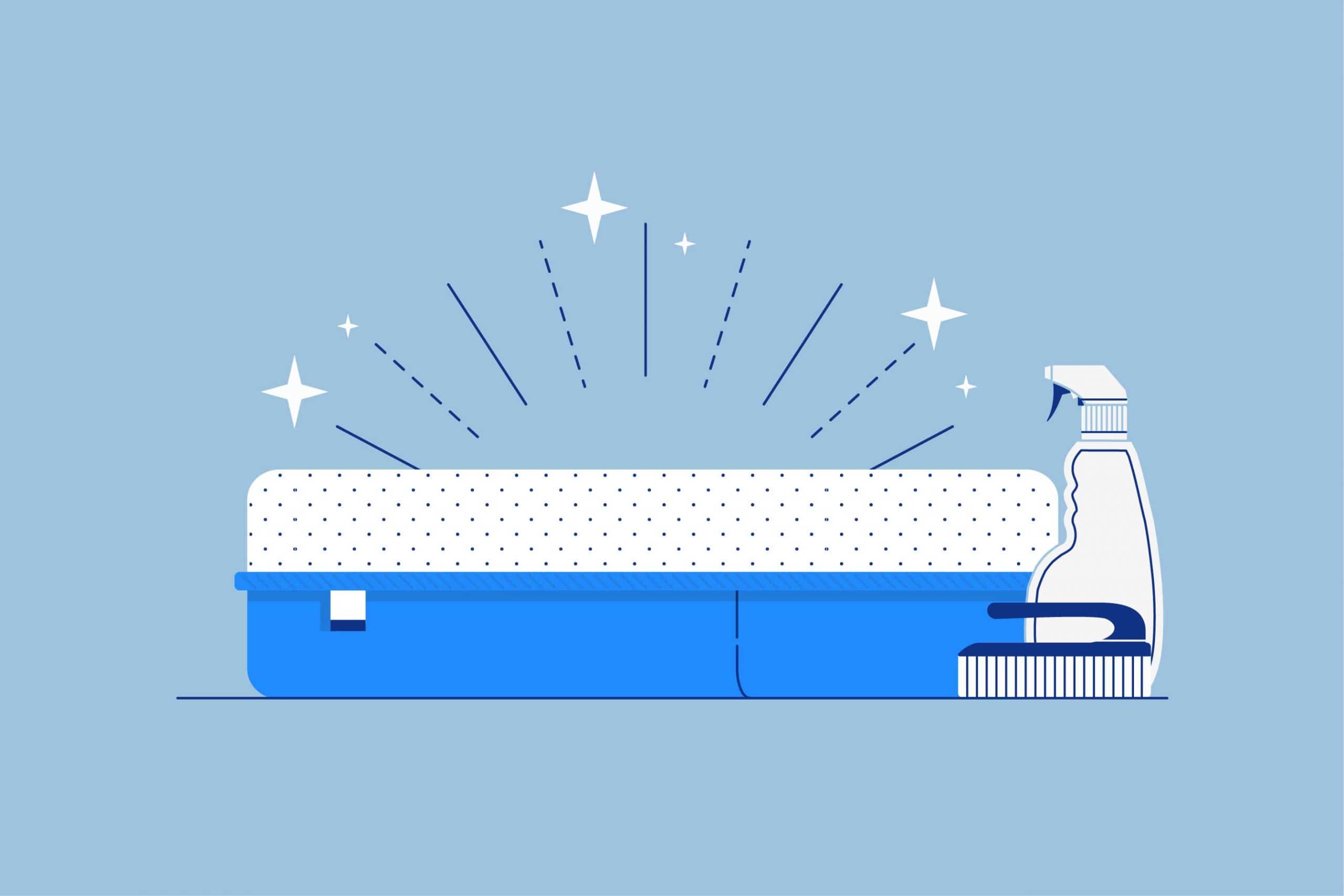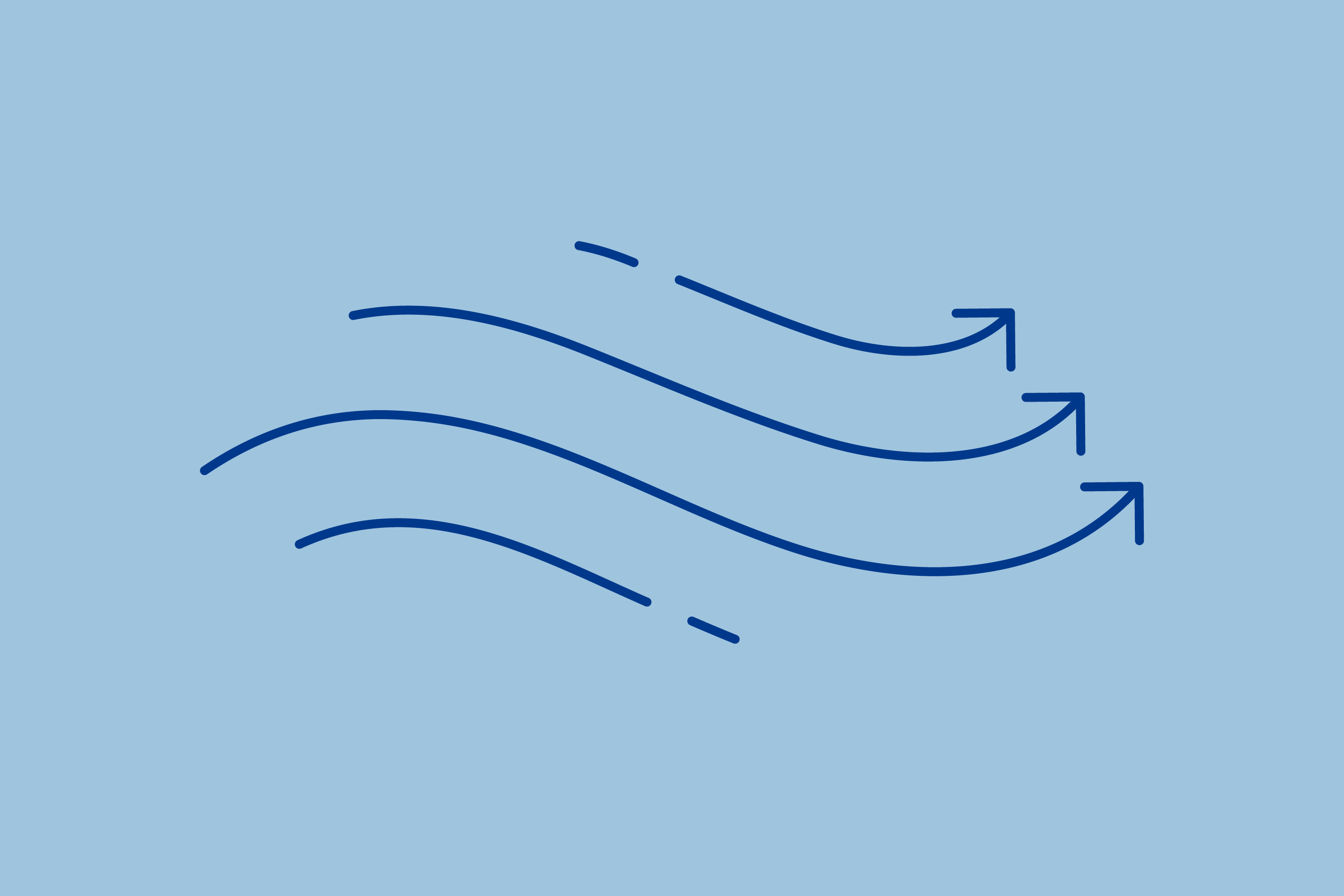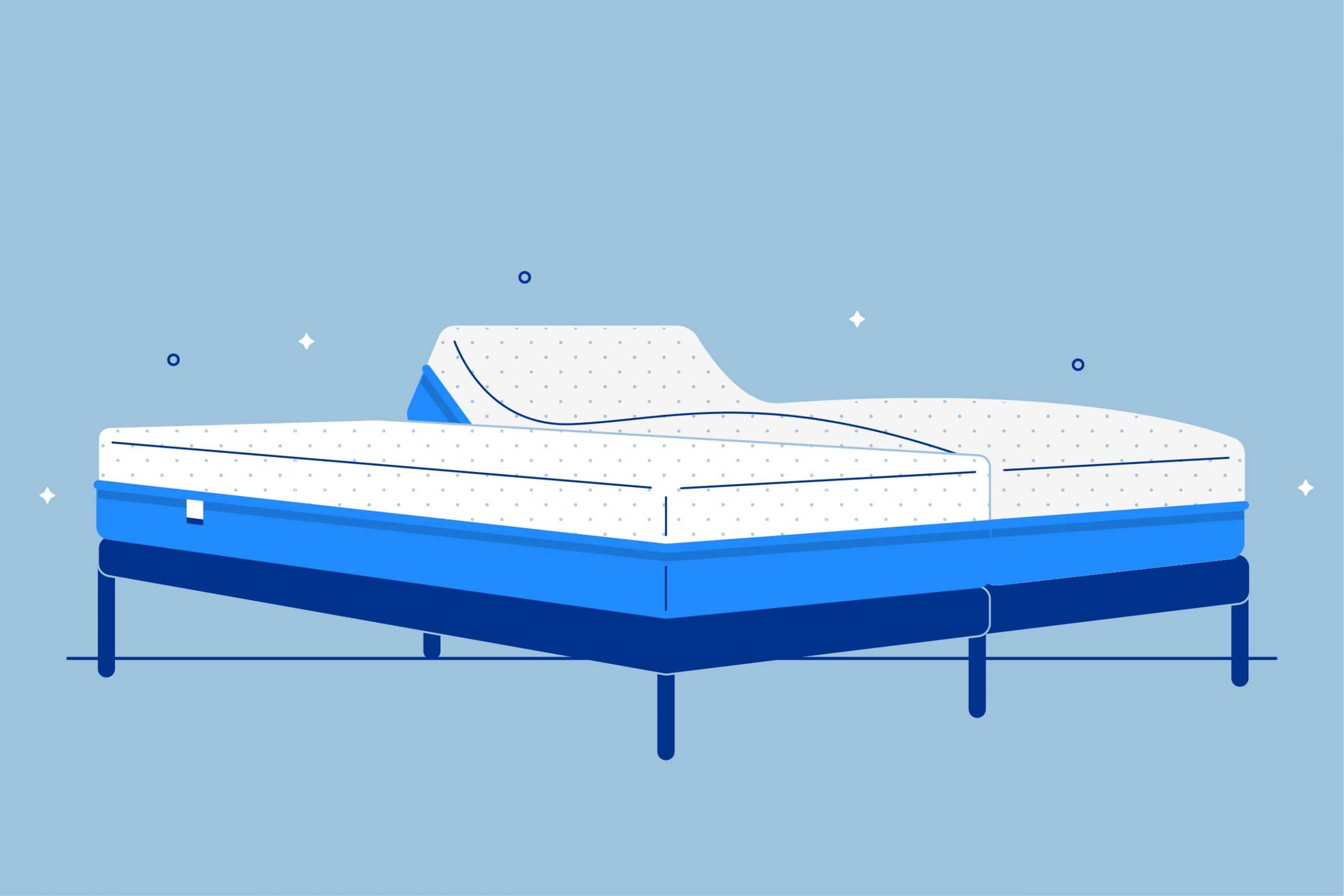Key Takeaways
- Importance of Cleaning Your Mattress: Mattresses can accumulate sweat, dead skin cells, dust mites, and other allergens over time, leading to unpleasant odors and potential health issues. Regularly cleaning and deodorizing your mattress can help prolong its life and maintain a fresh sleeping environment.
- Methods for Freshening and Deodorizing: Vacuum the mattress surface to remove dust and germs, use natural solutions like vinegar and baking soda to neutralize odors, and even incorporate essential oils for a pleasant scent. Regularly washing your bedding, including sheets and pillowcases, is also essential to prevent the buildup of allergens.
- Preventive Measures: Consider using a mattress protector to shield it from sweat, spills, and allergens. Additionally, maintain good hygiene by showering before bedtime to help reduce the transfer of sweat and oils to your mattress. Keeping your bedroom well-ventilated and clean can further prevent the growth of allergens and maintain mattress freshness.
While washing bedding may be a part of your weekly chores, mattresses also need some maintenance. You can freshen and deodorize your mattress to prolong its life and keep you healthy.
Any normal adult sweats and sheds dead skin cells during sleep, which gets absorbed by bedsheets and mattresses. Not only does this mean dealing with a sweat smell, but the moisture and skin cells provide a perfect environment for dust mites and other allergens to thrive in your bed.
Allergens may cause breathing difficulties, runny nose, sore throat, watery eyes, or skin irritation. This allergen build-up not only impacts your health, but it may also cause a bad odor, increasing the need to freshen and deodorize your mattress.
In this article, we will discuss how to freshen and deodorize your mattress.
How to Freshen and Deodorize a Mattress
Dust mites, sweat, other body oils, and skin cells permeate our bedding accessories and then the mattress. Freshening and deodorizing mattresses once every six months keeps allergens Verified Source National Library of Medicine (NIH) World’s largest medical library, making biomedical data and information more accessible. View source at bay.
Be cautious when you use any form of liquid on your mattress because it can leave moisture behind, encouraging allergen growth. This is why it’s often best to try dry ways of freshening your mattress first, such as odor-absorbing baking soda. If you do use liquid methods of deodorizing your mattress, air-dry your mattress thoroughly before making your bed.
Vacuum
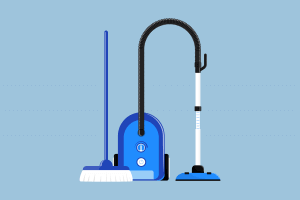 Use the upholstery attachment to clean all the dust and germs accumulated on your mattress. It’s also a good idea to vacuum around the bed frame to clean up any dust bunnies, body cast-offs, or pet dander on the floor.
Use the upholstery attachment to clean all the dust and germs accumulated on your mattress. It’s also a good idea to vacuum around the bed frame to clean up any dust bunnies, body cast-offs, or pet dander on the floor.
Before you vacuum your mattress, wash the upholstery attachment in warm water. Dust and germs sticking to the upholstery attachment will get washed away when you clean it with warm soapy water. Vacuum your bed’s surface, sides, even areas beneath the seams with the upholstery attachment to clean all the dust and germs accumulated on your mattress. Prop up your mattress and vacuum the other side of it too.
If you’re sensitive to allergens, you may want to use a HEPA vacuum cleaner, which cleans up the tiny allergens that a standard vacuum cleaner might miss.
Deodorize
Deodorizing your mattress eliminates odors left by the germs and allergens. A few regular kitchen items can be used to deodorize your mattress.
Water with Vinegar
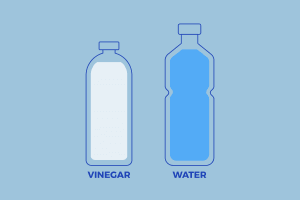 Vinegar neutralizes odors. Mixing it with water makes an organic deodorizer, so you don’t have to buy chemical sprays that may irritate your allergies. As a bonus, it’s a good solution for preventing mold on mattresses.
Vinegar neutralizes odors. Mixing it with water makes an organic deodorizer, so you don’t have to buy chemical sprays that may irritate your allergies. As a bonus, it’s a good solution for preventing mold on mattresses.
Mix equal portions of water and distilled white vinegar in a spray bottle. Lightly spray the solution over your mattress. Avoid making it too wet and let it air dry completely.
Then prop your mattress against the wall and spray the solution over the other side. Wait for the mattress to air dry thoroughly before you put it back on the bed base. Switch on fans and keep windows open to speed up the drying process.
Finish up by sprinkling baking soda on the mattress. This will deodorize any lingering odors. Then when it’s fresh and dry, place the mattress back on its foundation and follow the steps of making your bed.
Baking Soda
 Baking soda is a natural odor neutralizer. Apart from keeping it in your fridge, you can also use it on your memory foam pillows and mattresses. Use a flour sifter to sprinkle baking soda over your mattress surface and let it rest for at least 30 minutes. The longer you keep the baking soda, the better the results. You can leave it on for up to 24 hours.
Baking soda is a natural odor neutralizer. Apart from keeping it in your fridge, you can also use it on your memory foam pillows and mattresses. Use a flour sifter to sprinkle baking soda over your mattress surface and let it rest for at least 30 minutes. The longer you keep the baking soda, the better the results. You can leave it on for up to 24 hours.
While the baking soda sits on your mattress, keep your windows open to expose your bed to natural light. Sunlight dries up the moisture from your bed, further eliminating odors. Finally, vacuum your bed using the upholstery attachment to remove the baking soda.
Baking soda can be the best way to treat urine stains and smells, particularly if the spot is still wet. Though you may want to pair it with an enzyme cleaner for the best results.
Baking soda can also be a key part of drying a wet mattress after water damage, although some also turn to wet/dry vacs or sprinkled cat litter to sop up excess moisture after an accident or home leak.
Laundry Detergent
 A gentle laundry detergent can help eliminate odors from smelly stains, but you don’t want to just pour it over your mattress. Instead, mix laundry detergent with baking soda to create a paste. Then apply this paste to the mattress as a spot cleaner. Leave the mixture along for a while, then wipe it away with a towel or a kitchen utensil such as a knife or spoon.
A gentle laundry detergent can help eliminate odors from smelly stains, but you don’t want to just pour it over your mattress. Instead, mix laundry detergent with baking soda to create a paste. Then apply this paste to the mattress as a spot cleaner. Leave the mixture along for a while, then wipe it away with a towel or a kitchen utensil such as a knife or spoon.
You can also deal with a particularly smelly stain by mixing a splash of laundry detergent with two parts water and one part vinegar in a spray bottle. Gently mist over the affected area, being careful not to spray directly onto the mattress. Wipe up any excess moisture by blotting at the surface with paper towels.
Cornstarch
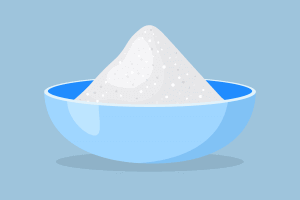 Cornstarch absorbs body oil, something else that may be making your bed smell. Mix cornstarch with baking soda and scatter it all over your mattress surface. Let the mixture rest on your bed for a day. Then vacuum the mattress surface to pick up the cornstarch-baking soda mixture.
Cornstarch absorbs body oil, something else that may be making your bed smell. Mix cornstarch with baking soda and scatter it all over your mattress surface. Let the mixture rest on your bed for a day. Then vacuum the mattress surface to pick up the cornstarch-baking soda mixture.
Essential Oils
 Mix 15 to 20 drops of your favorite essential oils with baking soda before sprinkling it over your mattress. Your bed may retain this fresh scent for a few days. We recommend using eucalyptus, lavender, peppermint, or lemon essential oils for a soothing effect.
Mix 15 to 20 drops of your favorite essential oils with baking soda before sprinkling it over your mattress. Your bed may retain this fresh scent for a few days. We recommend using eucalyptus, lavender, peppermint, or lemon essential oils for a soothing effect.
You can also try mixing two parts hydrogen peroxide with one part baking soda and a few drops of essential oils in a spray bottle, if you’re looking to get rid of troublesome stains along with any lingering mattress smells. Mist the mattress surface gently with the cleaning solution, then let it air-dry before you cover it back up with your assorted bedding.
See also our guide to the best essential oils for sleep.
Wash Your Bedding Regularly
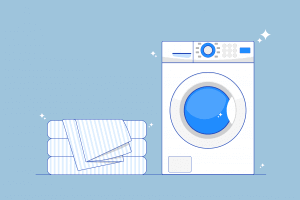 It’s best to wash your sheets, duvet covers, and pillowcases every week, eliminating sweat, skin cells, and allergens. Fewer bacteria and allergens on your bedding means fewer chances of dust and germs permeating your mattress.
It’s best to wash your sheets, duvet covers, and pillowcases every week, eliminating sweat, skin cells, and allergens. Fewer bacteria and allergens on your bedding means fewer chances of dust and germs permeating your mattress.
Wash your sheets in hot water unless the care label states to do otherwise. The high-temperature kills germs, ensuring you’re not sleeping in a bed with bacteria.
Wash your pillows once every three to four months to prevent allergen build-up. Putting your pillows and comforters out in the sun once in a while makes them fluffy because sunlight dries up the moisture in them. The UV rays from the sun also kill germs.
If you use a bed skirt, you’ll want to wash it every few months. If you can see visible dust on your bed skirt, it’s time for a cleaning.
We have a number of guides that go through the cleaning process for bedding items, step by step:
- How to Clean a Comforter
- How Often Should You Wash Your Sheets?
- How Often Should You Wash Your Mattress Protector?
- How to Wash a Body Pillow
- How to Wash a Quilt
- How to Wash a Duvet
- How To Clean a Memory Foam Mattress Topper?
- How Long Does It Take to Dry Clean a Comforter?
- How to Make Sheets White with Household Items
If you’re confused by the symbols on your bedding’s care label, we suggest looking at our laundry care symbol guide.
Remember that the type of fabric that makes up your bedding will influence how you treat it, such as the water temperature you wash it at and the type of detergent you can use. Or if you can wash the material at all. See also:
Other Steps to Prolong Mattress Freshness
Once you’ve freshened and deodorized your mattress, you’ll want to keep it clean for as long as possible. Following a few other steps maintains that freshness. You can sleep peacefully without having to worry about dust, germs, and allergens.
Use a Mattress Protector
 Mattress protectors protect your mattress from sweat, dust mites, allergens, accidental spills and stains. They’re easy to put on and a relatively inexpensive way to extend your mattress’s lifespan and minimize the need to clean a mattress of stains and such.
Mattress protectors protect your mattress from sweat, dust mites, allergens, accidental spills and stains. They’re easy to put on and a relatively inexpensive way to extend your mattress’s lifespan and minimize the need to clean a mattress of stains and such.
For children’s beds, mattress protectors are necessary to keep urine stains from bedwetting accidents lingering on the mattress. Slipping a protector over their mattress is easier than the cleanup needed for a mattress without a barrier.
Aside from the way that a waterproof mattress protector keeps out anything that can stink up your bed, they’re also excellent for sleepers who want to keep a hypoallergenic mattress pristine.
If you have a new mattress with a faint chemical smell, a mattress protector can also minimize how noticeable the smell is until your mattress finishes off-gassing. It can take a few hours to a few days before the temporary off-gassing smell dissipates, so a protector can make it easier to sleep at night.
You may wonder why a mattress protector is necessary if you have a mattress cover that’s wrapped around your bed’s materials. However, a mattress cover is typically not impermeable and it is usually not removable. As such, you cannot clean it the way you can a mattress protector, nor can it match a protector’s enveloping capabilities.
Keep Your Room Airy
 A damp mattress invites dust mites, bacteria, fungi, mold, mildew, spores, and more to rest on it. Some experts even advise waiting a little while after waking up before you take steps to make your bed, as this can allow time for lingering moisture in the bed to evaporate.
A damp mattress invites dust mites, bacteria, fungi, mold, mildew, spores, and more to rest on it. Some experts even advise waiting a little while after waking up before you take steps to make your bed, as this can allow time for lingering moisture in the bed to evaporate.
Keeping your ceiling fan on for an hour or a couple of hours after you wake up absorbs traces of moisture. See also our guide to sleeping with a fan on at night. Whenever possible, open your windows to allow natural light and air into your bedroom, prolonging your mattress’s freshness.
If you have the space and money for one, there are the filtering benefits of an air purifier to consider. Not only can a bedroom air purifier make breathing more pleasant, but it can help suck up anything that might settle on your mattress.
Lastly, you might want to consider a bedroom plant not just for decoration and a fresh fragrance, but as a way to improve your bedroom’s air. Carefully chosen houseplants can improve air quality, and you can enjoy the touch of soothing greenery it adds to the room, too.
Use a Bed Skirt or Dust Ruffle
A bed skirt does more than add a classic look to your bed frame. The main purpose of a bed skirt is to catch dust before it can pile up on the floor and under the bed, along with hiding your bed frame’s lower half, any bed risers you use, and underbed storage boxes.
You don’t need a panel bed and box spring to use a bed skirt, either. Platform beds can look quite elegant with a bed skirt, even if you have a floating bed frame designed with hidden legs. You can even pair certain bed skirts with an adjustable bed.
Clean Box Spring or Foundation
Your mattress usually rests on a box spring, bed foundation, or platform bed. Cleaning your mattress base along with your mattress prevents dust and germs from passing on to your mattress. Whenever you prop up your mattress for vacuum cleaning, remove the bed skirt (if you have one) and wash it.
Vacuum the surface of the box spring, foundation, or platform bed. A mattress resting on a clean base will stay fresh for longer. We suggest vacuuming your bed base as part of your regular mattress cleaning routine.
We also want to stress the importance of using a bed base, as it keeps your bed elevated from the dust, dead skin, and other cast-offs that accumulate on the floor. Keeping your mattress on the floor directly also increases the risk of moisture and heat build-up, which can enable mold growth.
Stay Clean and Eat Carefully
Our bodies naturally produce sweat and body oils, which can seep into the mattress over time. Regularly showering before bedtime and ensuring your body is clean can reduce the amount of these substances transferred to your mattress. By doing so, you help prevent the buildup of odor and stains on your mattress.
Avoid eating or drinking in bed to prevent spills and crumbs from reaching your mattress. Make sure to watch what you eat before bed, too. Even excessive farting in your sleep can stink up your mattress, and indigestion is often caused by eating foods you’re intolerant to or otherwise have difficulty disgesting.
FAQs
Can you machine wash mattress pads?
Yes, you can machine wash most mattress pads. But we recommend checking the instructions on the care label. While machine washing, it’s best to avoid warm or hot water, because it can damage the mattress pad. Wash it on a gentle cycle with a mild detergent. Tumble dry low or air dry it. Wash your mattress pad every other month to reduce dust and allergen build-up.
We also want to make it clear that there’s a difference between mattress pads and mattress toppers. A mattress pad is quite thin and acts like a fitted sheet with a touch of extra cushion, while a mattress topper is typically at least a couple of inches thick.
Can you remove mold and mildew growing inside a mattress?
No, there’s no way to remove mold and mildew growing inside a mattress. All the steps to freshen and deodorize your mattress remove mold, mildew, dust, and germs from your mattress surface, but not the inside.
If your mattress still emits a stale odor even after washing, chances are mold and mildew are growing inside. In such cases, it’s better to buy a new mattress quickly to replace your old and moldy one. You cannot donate a mattress with mold growing inside it, so we suggest reaching out to junk removal services instead.
How do you get the smell out of a new mattress?
Air out your mattress for a couple of days and if it still emits an odor then you can sprinkle some baking soda over it. Let it sit overnight and vacuum it the next day. A few drops of your favorite essential oil can be mixed in with the baking soda for a pleasant, soothing smell.
To prevent smells from setting into your new mattress, an impermeable mattress protector is crucial. Waterproof mattress protectors effectively isolate the mattress in a sterile environment, preventing microbes from penetrating the surface of the mattress and causing a stink. In other words, it keeps the mattress fresh with little work needed.
How to spot clean mattress stains?
To spot clean a mattress, make a solution to rub on the stain by mixing equal portions of salt, baking soda, and distilled white vinegar. Then, let this solution rest on the stain for about 30 minutes. When time’s up, use a damp microfiber cloth to remove the paste and the stains.
Be careful to avoid circular motions because they might set the stain. Instead, use pressing motions to remove the stain and moisture. Once you’ve completed those steps, let it air dry properly before making the bed.
How do dust mites affect your health?
Dust mites can trigger symptoms such as watery eyes, runny nose, itchy throat, skin rashes, or breathing difficulties in those prone to allergies. They may be harmless for others, but the thought of sleeping on a bed full of allergens is not pleasant. While dust mites are all but impossible to entirely eliminate, maintaining a bedroom as free of dust as possible helps.
Do bed bugs smell?
Yes, bed bugs can release alarm pheromones if they’re disturbed, and the odor smells quite unpleasant. Aside from the smell, you can also recognize bed bugs by their look and the droppings they leave. The body of a bed bug is visible to the naked eye and looks like a reddish-brown apple seed.
Once they infest a bedroom, it’s difficult to get bed bugs out of a mattress. That is why it’s important to take precautions and avoid bringing them into the house after a traveling trip.
Conclusion
A bed free of germs and dust mites won’t trigger allergic reactions and disrupt sleep. A well-maintained mattress lasts longer, potentially saving you money because you don’t have to replace your mattress soon.
About the author
Sanchita Sen is a full-time writer focusing on the sleep health and mattress industry. She is a former journalist who has written numerous articles on the healthcare sector. Some of the topics she has covered include how to lucid dream, fever dreams, melatonin for sleep, and best gel memory foam mattress. Sanchita holds a Master of Arts in Communications from Convergence Institute of Mass Media and Information Technology Studies. She is also a published author, who seeks inspiration from both real life and the world of fiction.
View all posts